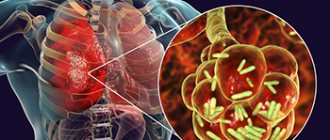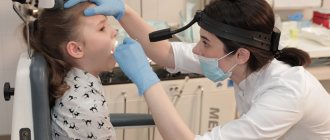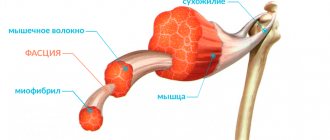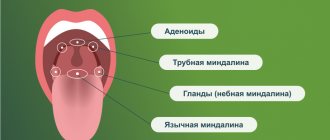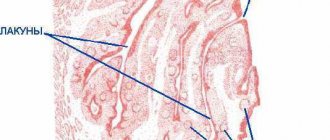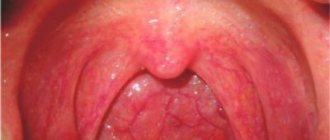Every person experiences a sore throat sooner or later. But this seemingly harmless symptom can cause serious problems.
Acute tonsillitis (tonsillitis) is an infectious disease that causes inflammation of the tonsils. Statistics show that about 15% of children suffer from an acute form of the disease. In the adult population, this figure is lower - 5-10%. But almost every person in large cities suffers from chronic tonsillitis. Why? Let's find out!
The acute form of tonsillitis, which goes away with an increase in body temperature and severe pain in the throat, is more familiar to us as a sore throat. In the chronic form, the patient may not even realize that he has this disease for a long time. A person may feel that periodic sore throats and frequent colds are simply the result of a weakened immune system. Such a careless attitude towards one’s health can cause serious complications and pathologies. To avoid them, it is necessary to diagnose the problem in time: know the first signs, symptoms and treatment.
Make an appointment right now!
Call us by phone or use the feedback form
Sign up
Why are tonsils needed?
The tonsils are an integral part of our immune system. And their main purpose is to protect the body from the penetration of pathogenic bacteria and viruses. In total, a person has six of them: palatine and tubal (paired), pharyngeal and lingual. By their names you can roughly understand in which part of the pharynx they are located. Their general arrangement resembles a ring. This ring acts as a kind of barrier for bacteria. When we talk about inflammation of the tonsils, we mean only the palatine tonsils (aka tonsils). Let's look at them in more detail.
If you open your mouth wide, then in the mirror you can easily see two formations that look like almonds - tonsils, these are tonsils. Each tonsil consists of small openings (lacunae) and winding canals (crypts).
Bacteria that enter the air, in contact with the tonsils, are rebuffed and are immediately disposed of, without having time to cause an outbreak of a particular disease. Normally, a healthy person does not even suspect that real fighting is taking place inside him. Now you understand the importance of the mission of the palatine tonsils. Therefore, a good otolaryngologist will never rush to recommend their removal. Although to hear from a doctor, speaking about tonsils: “They need to be removed!” - a common phenomenon in our time. Unfortunately, today not all clinics can offer high-quality treatment for tonsillitis, and sometimes the turnaround rate is off the charts. That is why it is sometimes easier for a doctor to brush it off and refer the patient for surgery.
What tests need to be taken for tonsillitis?
In order to determine the pathogen and determine further treatment, the doctor may prescribe a number of laboratory tests to the patient, for example:
- a smear from the tonsils, arches and back of the throat to identify bacteria and their resistance to various groups of antibiotics, but such a study may take several days
- rapid test for the detection of group A beta-hemolytic streptococcus to determine streptococcal tonsillitis5
- a general blood test with a leukocyte formula, which pays attention to elements that reflect inflammation and the immune response to the disease. Increased band neutrophils, leukocytes, increased ESR, decreased lymphocytes
- CRP (C-reactive protein - a marker of inflammation) is the most sensitive protein responsible for inflammation in the body
Types of tonsillitis.
The disease occurs in two forms - acute and chronic. Acute tonsillitis is an illness of an infectious nature and manifests itself in acute inflammation of the tonsil. The cause of exacerbation is staphylococci and streptococci. Acute sore throat in children and adults is also divided into catarrhal, follicular, lacunar, ulcerative-membranous and necrotic.
Chronic tonsillitis is a long-term, persistent inflammatory process in the tonsils. It manifests itself as a consequence of past inflammation, acute respiratory viral infections, dental diseases, and reduced immunity. Chronic exacerbation of the disease in adults and children occurs in three forms: compensated, subcompensated and decompensated. In the compensated form, the disease “dormants”; exacerbation of tonsillitis symptoms occurs infrequently. In the case of a subcompensated form of the disease, exacerbations occur frequently, the disease is severe, and complications are common. The decompensated form is characterized by a long, sluggish course.
Clinical manifestations
The symptoms of tonsillitis depend on its form, which can be simple or toxic-allergic.
Signs of a simple form:
- Exacerbations no more than 1-2 times a year;
- Between exacerbations the general condition is not disturbed;
- There are no systemic manifestations of tonsillitis (no damage to other organs, no intoxication, general condition does not suffer);
- Local manifestations of the inflammatory process.
Signs of the toxic-allergic form are:
- Changes in the blood (they are detected by general clinical, biochemical and immunological analysis);
- Tonsillogenic intoxication;
- Symptoms of damage to internal organs (heart, blood vessels, kidneys, etc.), which are associated with the development of rheumatism, glomerulonephritis, vasculitis, septic endocarditis, etc.
Taking into account the severity of clinical symptoms, the toxic-allergic form can be grade 1 or 2. The differences between them are taken into account by B.S. Preobrazhensky’s classification.
Symptoms of tonsillitis.
A symptom that combines both types is pain in the throat. The pain can be both severe and tolerable. The patient experiences severe discomfort while eating and swallowing.
Sore throat is much more severe than a chronic disease and is accompanied by the following symptoms:
- increased body temperature (up to 40°C);
- very severe sore throat;
- enlarged lymph nodes;
- accumulations of pus on the tonsils (plaque, pustules);
- enlarged tonsils;
- headache;
- weakness.
The symptoms and treatment of chronic tonsillitis are somewhat different from the manifestations of tonsillitis. With a chronic disease, the temperature remains at 37°C. A sore throat, cough, and bad breath are added. There is a white coating on the tonsils. The symptoms are less pronounced, since the course of the disease itself is characterized by remissions and exacerbations. A patient suffering from a chronic form of the disease loses his ability to work, gets tired quickly, and loses his appetite. Often a person suffers from insomnia.
Possible complications.
Both forms of the disease: chronic and acute, can cause serious complications. One of the most severe consequences of the disease is rheumatism. Practice shows that half of the patients suffering from rheumatism had to be treated for chronic tonsillitis or treated for acute conditions a month earlier. The disease itself begins with unbearable joint pain and increased body temperature.
There are frequent cases of heart disease caused by tonsillitis. Patients experience shortness of breath, interruptions in the functioning of the heart muscle, and tachycardia. Myocarditis may develop.
If inflammation spreads to tissues nearby the tonsil, paratonsillitis appears. The patient suffers from a sore throat and fever. If the infection from the tonsils spreads to the lymph nodes, lymphadenitis appears.
Untreated tonsillitis also leads to kidney disease.
A sore throat
Roza Ismailovna Yagudina, Ph.D.
Sc., prof., head. Department of Organization of Drug Supply and Pharmacoeconomics and Head. laboratory of pharmacoeconomic research of the First Moscow State Medical University named after. I. M. Sechenov. Evgenia Evgenievna Arinina, Ph.D., leading researcher at the laboratory of pharmacoeconomic studies of the First Moscow State Medical University named after. I. M. Sechenov.
One of the most common complaints in the autumn-winter and, oddly enough, in the summer periods is a sore throat. The causes of painful sensations can be various pathogenetic processes occurring in the human body, and in the summer - also a violation of the environmental situation (humid, dusty air, air conditioners). The most common types of throat lesions are laryngitis, pharyngitis and tonsillitis. The last of these diseases is inflammation of the tonsils. Tonsillitis is the most common cause of sore throat; moreover, the inflammation often has a chronic course.
Causes and mechanism of tonsillitis
Sore throat, according to patients themselves, is always associated with hypothermia. However, the etiology of the development of oropharyngeal lesions is very diverse: from bacteria to viruses. The occurrence of pain in these cases is almost always associated with damage to the palatine tonsils, located on the side walls of the oropharynx - the junction of the respiratory and digestive tracts. The tonsils have many lacunae into which crypts or sacs open, having a dichotomous division and immersed in the depths of the tonsils. This structure of the tonsils contributes to the accumulation of various exudates in them. The palatine tonsils do not have afferent lymphatic vessels, since they themselves actively produce lymphocytes. Also, the palatine tonsils take an active part in the formation of local and general immunity.
NB ! A sore throat should not be confused with chronic tonsillitis (more precisely, its exacerbation, which, with similar symptoms, requires different treatment).
Sore throat is a general infectious disease with acute inflammation of the components of the lymphadenoid pharyngeal ring (usually the palatine tonsils). Sore throats are divided into: primary, secondary and specific.
- Primary - ordinary, simple, or banal sore throats. They manifest themselves as acute inflammatory diseases that have signs of damage only to the lymphadenoid ring of the pharynx.
- Secondary - symptomatic tonsillitis. Damage to the tonsils with scarlet fever, diphtheria, infectious mononucleosis, etc., as well as with blood diseases - leukemia, agranulocytosis, acute infectious diseases.
- Specific - sore throats caused by specific infections (fungal tonsillitis, Simanovsky-Plaut-Vincent tonsillitis).
Chronic tonsillitis is a chronic inflammatory, periodically exacerbating focus of infection in the palatine tonsils with a general infectious-allergic reaction.
The mechanism of infection spread is airborne, mainly occurs when coughing, sneezing, kissing, sharing dishes, towels, etc. The most common cause of chronic tonsillitis is group A β-hemolytic streptococcus, other pathogens are St. Aureus, H. influenzae, M. Catarrhalis, N. Gonorrhoeae, C. haemolyticum, M. Pneumoniae, C. pneumoniae, Toxoplasma, anaerobes, adenoviruses, cytomegaloviruses, herpes viruses, etc. Chronic tonsillitis is not always a consequence of previous tonsillitis. In most cases, it develops unnoticed, masquerading as other diseases (ARVI, stomatitis, etc.). As tonsillitis progresses, the parenchyma of the tonsils is slowly replaced by connective tissue, encapsulated foci of necrosis are formed, and regional lymph nodes are involved in inflammation. There are several forms and types of chronic tonsillitis with different symptoms.
The presence of only local signs characterizes simple tonsillitis (initial stage)
- liquid pus or caseous-purulent plugs in the lacunae of the tonsils (sometimes with an odor);
- tonsils are small, sometimes smooth or with a loose surface;
- persistent hyperemia of the edges of the palatine arches (Gise's sign);
- swelling of the edges of the upper parts of the palatine arches (Zach's sign);
- thickened, roller-shaped edges of the anterior palatine arches (Preobrazhensky sign);
- fusion and adhesions of the tonsils with the arches and triangular fold;
- enlargement of individual regional lymph nodes, sometimes painful on palpation (in the absence of other foci of infection in this region).
Also at this stage, other diseases not related to tonsillitis may worsen, which can have serious consequences.
Toxic-allergic form I (TAF I ) - is caused by repeated previous sore throats. In addition to local symptoms (the same as at the initial stage), general toxic-allergic phenomena develop:
- low-grade body temperature (occasionally);
- weakness, malaise;
- increased fatigue, decreased ability to work;
- periodic joint pain;
- enlargement and pain on palpation of regional lymph nodes (in the absence of other foci of infection);
- functional disorders of cardiac activity (can manifest themselves during exercise and at rest, but only during exacerbation);
- Abnormalities in laboratory data are variable.
Concomitant diseases in this case are the same as in the simple form, but they do not have a common infectious basis with chronic tonsillitis.
Toxic-allergic form II (TAF II ) - characterized by local symptoms inherent in the simple form and general toxic-allergic reactions:
- periodic functional disorders of cardiac activity (disturbances in heart rhythm are recorded on the ECG, pain in the heart area occurs both at the latent stage and at the acute stage);
- joint pain (both at the latent stage and at the acute stage);
- low-grade fever (may be prolonged);
- functional kidney disorders;
- deviations from laboratory data norms.
Concomitant diseases may be the same as in the simple form (not associated with infection). The course of this stage of chronic tonsillitis may be accompanied by the development of severe complications: peritonsillar abscess, tonsillogenic sepsis, etc.
Treatment of tonsillitis
How to get rid of tonsillitis? The palatine tonsils play a large role in the normal functioning of the immune system, so treatment of the disease should first of all include the restoration of the body's protective functions. Pharmacotherapy for chronic tonsillitis includes a set of measures aimed at eliminating the bacterial environment, relieving inflammation and eliminating purulent plugs from the pharyngeal mucosa. Treatment of chronic tonsillitis is carried out in accordance with the form and phase of the disease (acute tonsillitis, latent).
NB ! Conservative therapy is carried out at the initial stage of the disease and TAF I outside the period of exacerbation and not earlier than 1 month after it. Patients with TAF II are indicated for tonsillectomy!
Principles of pharmacotherapy of chronic tonsillitis:
- antibacterial drugs. To treat tonsillitis, various types of antibiotics are used: penicillins (mostly “protected”) or cephalosporins (2nd or 3rd generation), macrolides can be used, less often fluoroquinolones;
- desensitizing drugs that have an anti-edematous effect on tissues and help facilitate tolerance and improve the absorption of prescribed therapy;
- oral antiseptics: miramistin, octenisept at a dilution of 1:5, various gargles, etc. (how to gargle for tonsillitis is described below);
- homeopathic preparations that normalize and improve the trophism of the palatine tonsils;
- drugs that stimulate local immunity of the palatine tonsils.
Antibacterial therapy - what antibiotics are taken for tonsillitis
- Penicillins: preference in this group is given to amoxicillin in combination with clavulanic acid, since it is this combination that ensures the effectiveness of treatment in the event of penillinase-producing staphylococci joining the pathogenic flora. However, they are ineffective against methicillin-resistant strains of Staphylococcus aureus.
- Cephalosporins: cefepime (IV generation), ceftriaxone, cefoperazone, cefixime (III), cefuroxime (II). The first three drugs have only parenteral forms of release, while cefixime is produced only in oral form. Cefuroxime has both forms of release.
- Macrolides: azithromycin, clarithromycin, josamycin. The drugs are active against all pathogens, including penicillin-resistant strains.
- Aerosol forms of antibacterial drugs: fusafungine, active against hemolytic streptococcus, Staphylococcus aureus and Candida albicans.
Immunomodulators
Immunomodulators are prescribed as part of complex therapy. Among vaccine-like immunomodulators that activate both specific and nonspecific local immunity, preparations containing lysates of thirteen microorganisms are used (including lysates of hemolytic streptococcus, Staphylococcus aureus, Candida albicans). A similar mechanism of action (increased phagocytosis, increased lysozyme content, stimulation of immunoglobulin A production) is also characteristic of nasal sprays containing bacterial lysates: Streptococcus pneumoniae type I, II, III, V, VIII, XII, Staphylococcus aureus, Neisseria subflava, Neisseria perflava, Klebsiella Pneumoniae, Moraxella Catarrhalis, Haemophilus Influenzae Type B, Acinetobacter Calcoaceticus, Enterococcus Faecum, Enterococcus Faecalis, Streptococcus Pyogen ES Group A, Streptococcus Dysgalae Group C, Streptococcus Group G. Natural immunostimulating agents are also used: ginseng, leftze, echinacea, chamomile, garlic, garlic, garlic propolis, pantocrine. Peptides with immunoregulatory, detoxification, hepatoprotective, antioxidant effects are also used as an immunomodulator - arginyl-alpha-aspartyl-lysyl-valyl-tyrosyl-arginine, azoximer bromide, glucosaminyl muramyl dipeptide. Recently, herbal medicines such as tonsiral and tonsilgon have become widespread.
Antiseptics
Rinse solutions
An important stage in the treatment of sore throat is the sanitation of the oropharynx using a variety of antiseptics. The best option for sanitation is systematic (up to 8-10 times a day) gargling for tonsillitis with antiseptic and anti-inflammatory solutions of furatsilin, tinctures of eucalyptus leaves (have an antimicrobial effect), calendula, propolis (have an antiseptic and anti-inflammatory effect), preparations containing the NSAID agent benzydamine and so on.
Sprays and lozenges
The above-mentioned benzydamine is available not only in the form of a solution, but also in the form of a spray, which provides the so-called “spot” sanitation of the oropharynx. Other sprays used for sore throats contain hexethidine, povidone-iodine, mixtures of camphor, levomenthol, chlorobutanol and eucalyptus oils.
Another convenient local form of throat sanitation is lozenges and lozenges based on the same antiseptics (a combination of dry sage extract with essential oil, ambazone, chlorhexidine in combination with tetracaine and vitamin C). As a rule, in addition to the analgesic effect, tablets and lozenges have a bactericidal, local anesthetic and immunomodulatory effect. The basis for local drugs for resorption can also be drugs from the PNVP group: flurbiprofen, acetylaminonitropropoxybenzene, benzydamine.
Antioxidants
Antioxidants in the treatment of sore throat are used to improve metabolism, restore the functioning of enzyme systems and reduce the destructive effects of free radicals and peroxide compounds, as well as to improve immunity (rutin-containing complexes, vitamins A, E, C, microelements Zn, Mg, Si, Fe , Ca, dietary supplements, etc.).
Criteria for treatment effectiveness
Indicators that the treatment is sufficiently effective are:
- disappearance of pus and pathological contents in the tonsils;
- reduction of hyperemia and infiltration of the palatine arches and palatine tonsils;
- reduction or disappearance of regional lymph nodes.
But even in this case, it is better to carry out courses of treatment at least three times a year, especially during the off-season.
However, if a patient has a relapse even with a simple form of chronic tonsillitis or TAF I, then after the first course of treatment, pus remains in the palatine tonsils and caseous masses form, so it is necessary to discuss with the patient the possibility of tonsillectomy.
Thus, conservative treatment of chronic tonsillitis should to some extent be considered as a stage in preparing the patient for tonsillectomy for chronic tonsillitis TAF I, and in a simple form (if there is a positive result of treatment), the patient must be taught to maintain the tonsils in a satisfactory condition - that is, to carry out prevention chronic tonsillitis. Many people are interested in how to cure chronic tonsillitis once and for all. Unfortunately, there are no universal recipes for the treatment of chronic tonsillitis, since it is a focal infection that constantly reduces immunity and can at any time cause an exacerbation of the patient’s condition.
Table 1. List of drugs for the treatment of chronic tonsillitis in adults and children (group Rx)
Drugs for the treatment of chronic tonsillitis (exacerbation stage). Prescription group (Rx-drugs)*
| INN | TN |
| Penicillin series | |
| Amoxicillin + clavulanic acid | Panclave 2X, Panclave, Augmentin®, Augmentin EC, Augmentin® SR, Amovycombe®, Arlet®, Amoxiclav® Quiktab, Amoxiclav®, Ecoclave®, Flemoklav Solutab, Fibell, Rapiclav, Ranclave®, Medoclav, Liclave, Klamosar, Verclave, Bactoclav , Amoxicillin + clavulanic acid-Vial, Amoxicillin + clavulanic acid, Amoxicillin + clavulanic acid Pfizer |
| Cephalosporins II generation | |
| Cefuroxime | Cefurus®, Cefuroxime Kabi, Cefuroxime, Cefurabol®, Cefuroxime J, Cetyl Lupine, Super, Proxim, Xorim, Kefstar, Ketocef, Zinoximor, Zinacef®, Zinnat®, Acenoveriz®, Antibioxime, Axosef®, Aksetin® |
| III generation | |
| Cefoperazone+[Sulbactam], | Tsefpar SV, Cefoperazone and Sulbactam Spencer, Cefoperazone and Sulbactam Jodas, Cebanex, Sulcefazone, Sulcef, Sulperacef®, Sulperazone, Sulmover®, Sulzoncef®, Pactocef |
| Cefoperazone | Cefpar, Cefoperus®, Cefoperazone-Vial, Cefoperazone-Agio, Cefoperazone, Cefoperabol®, Cefobid®, Ceperon J, Operaz, Movoperiz, Medocef, Dardum |
| Ceftriaxone | Ceftriaxone-Promed, Ceftriaxone-LEKSVM®, Ceftriaxone-KMP, Ceftriaxone-Jodas, Ceftriaxone-Darnitsa, Ceftriaxone-Vial, Ceftriaxone Elfa, Ceftriaxone Protech, Ceftriaxone Kabi, Ceftriaxone DS, Ceftriaxone Danson, Ceftriaxone, Ceftria bol®, Cefson, Cefogram, Cefatrin , Cefaxon, Hizon, Triaxone, Torocef®, Tercef®, Stericef, Rocephin®, Oframax®, Movigip, Medaxone, Loraxone, Lifaxone, Lendacin®, Ifitzer®, Biotraxon, Betasporina, Axone, Azaran |
| Cefixime | Ceforal Solutab, Cemidexor®, Suprax®, Pancef, Pancef®, Ixim Lupin |
| IV generation | |
| Cefepime | Epipim, Cefomax, Cefepim-Jodas, Cefepim-Vial, Cefepim-Agio, Cefepim, Movisar, Maxicef®, Maxipim®, Ladef, Cefsepim, |
| Macrolides | |
| Azithromycin | Ecomed®, Hemomycin, Tremac-Sanovel, Sumatrolide solutab, Sumamox, Sumametcin, Sumamed® forte, Sumamed®, Sumaclid, Safocid, Zi-factor®, Zitrocin, Zitrolide® forte, Zitrolide®, Zitnob®, Zetamax retard, Azicide, AzitRus forte, AzitRus, Azithromycin-McLeodz, Azithromycin-BI, Azithromycin-OBL, Azithromycin Forte, Azithromycin, Azitrox®, Azitral, Azimicin, Azivok |
| Clarithromycin | Ecositrin, Helitrix®, Fromilid Uno, Fromilid, SR-Klaren, Seydon-sanovel, Lekoklar, Coater, Clerimed, Klacid® SR, Klacid®, Klasine, Claromin, Claricite, Claricin, Clarithrosin, Clarithromycin-Teva, Clarithromycin-Verte, Clarithromycin retard-OBL, Clarithromycin Pfizer, Clarithromycin Protech, Clarithromycin Zentiva, Clarithromycin, Clarbact, Klabax®, Klabax OD, Kispar® Zimbactar |
| Josamycin | Vilprafen, Vilprafen solutab |
* State register of medicines
The more appropriate form of release of the drug in this case is determined by the doctor.
Table 2. List of drugs for chronic tonsillitis at the acute stage (tablets, solutions, sprays)
| INN | TN | Release forms |
| Fusafungin | Bioparox® | dosed aerosol for inhalation |
| Lysates of microorganisms | Kameton-MHFP Kameton | aerosol for topical use topical spray |
| Salvia officinalis leaf extract + Salvia officinalis leaf oil | Sage | lozenges |
| Ambazon | Faringosept | lozenges |
| Flurbiprofen | Strepfen, Strepsils® Intensive Rakstan-Sanovel | lozenges [honey-lemon] film-coated tablets |
| Benzydamine | Tantum verde forte Tantum verde | dosed topical spray dosed spray for topical use, solution for topical use, lozenges |
* State register of medicines
Pregnancy and chronic tonsillitis.
The health of the expectant mother and baby requires close attention. Complications caused by the disease can lead to dangerous consequences, including miscarriage or provoke premature birth. Self-medication in this case is dangerous: it is necessary to undergo treatment with an ENT specialist in the clinic. The doctor will prescribe washing the tonsils, treating them with ultrasound and gargling with antiseptics that are safe for the expectant mother. Physiotherapy is contraindicated for pregnant women.
If you are just planning a pregnancy, it is worth carrying out planned therapy for prevention in order to reduce the negative impact of pathogens on the tonsils. At the planning stage of pregnancy, it is recommended that both parents undergo an examination to reduce the risk of this disease in the child.
Friends! Timely and correct treatment will ensure you a speedy recovery!
Acute tonsillitis. Treatment.
Self-medication for this disease is unacceptable! To choose an effective method of treatment during exacerbation, it is necessary to treat tonsillitis in children and adults under the supervision of an ENT doctor. It should be remembered that the acute form of the disease is extremely contagious. When the first signs of the disease appear, a number of measures must be taken to promote a speedy recovery of the patient:
- the sick person must be isolated by placing in another room. He must have his own towel, linen and dishes, since the disease is very contagious;
- during the treatment period the patient is prescribed strict bed rest;
- take care of the patient’s nutrition: food should not be solid, so as not to cause unnecessary concern to the sore throat;
- do not forget about drinking plenty of fluids;
- a course of antibacterial therapy is prescribed (Amoxiclav, Azithromycin, etc.). It is necessary to completely drink the entire course of antibiotics, even if the patient feels a noticeable improvement;
- For local treatment, drugs with an antibacterial effect are used;
- when treating a throat with tonsillitis, the drugs “Tantum-verde”, “Inhalipt”,
- rinsing with antiseptics (“Chlorgequidine”, “Furacilin”);
- lubricating the tonsils with Lugol's solution;
- to relieve swelling of the tonsils, you need to take allergy medications;
- If your body temperature is above 38°C, take antipyretics based on ibuprofen or paracetamol.
Prevention
You can avoid acute tonsillitis in a child or adult if you follow some rules:
- Maintaining immunity through hardening, proper nutrition, normalization of work and rest;
- Avoiding hypothermia in the autumn-winter period;
- Avoiding sudden changes in temperature in summer (air conditioning, cold drinks, ice cream, etc.);
- Taking special immunostimulating agents that activate the body’s local defenses (Imudon®)4.
Secondary prevention, which involves preventing complications of angina, includes compliance with all treatment recommendations3. In addition, taking local immunomodulators that reduce the number of bacteria on the tonsils is encouraged.
Treatment of chronic tonsillitis.
When treating this disease, the rule applies: exacerbation of chronic tonsillitis should be treated in combination with the treatment of concomitant diseases of the nose and nasopharynx. Inflammation of the glands can be treated, but, for example, mucus constantly flowing down the wall of the pharynx due to constant inflammation of the inferior turbinates will provoke new inflammation.
Tonsillitis treatment clinics offer two treatment options: conservative and surgical. For compensated and subcompensated forms, conservative therapy is prescribed. In the decompensated form, when all conservative methods of therapy have been tried and they have not brought results, they resort to removing the tonsils. But by losing them, a person loses his natural protective barrier, so the surgical method should be considered as a last resort.
Drug therapy for the chronic form of the disease includes:
- treatment with antibiotics prescribed by an otolaryngologist;
- use of antiseptics (“Miramistin”, “Octenisept”);
- antihistamines to relieve swelling of the tonsils;
- immunomodulators to stimulate weakened immunity (for example, Imudon);
- homeopathic remedies (“Tonsilgon”, “Tonsillotren”)
- herbal decoctions: chamomile, sage, string;
- if necessary, prescribe painkillers;
- adherence to a diet (no solid food, very cold or hot, alcohol, coffee and carbonated drinks are excluded).
Features and causes of the disease
Tonsillitis occurs in acute (angina) and chronic forms. The peak incidence occurs in the autumn or spring. Children get sick twice as often as adults. Due to the structural features of the organs of the peripheral immune system, which include the tonsils of the peripharyngeal ring, they often do not perform a protective function, but themselves become a source of infection due to constant inflammation in them.
Tonsillitis occurs due to a weakened immune defense and in the presence of provoking factors. The development of the disease is promoted by:
- hypothermia of the body;
- bad habits: smoking and alcohol abuse;
- hypo and vitamin deficiencies;
- throat injuries;
- chronic inflammatory diseases of the nasal and throat cavities, paranasal sinuses;
- uncontrolled use of hormonal drugs;
- hereditary predisposition to throat diseases;
- hypoplasia of lymphoid tissues and other causes.
The disease can also provoke impaired nasal breathing and concomitant somatic diseases of various organs and systems that affect the overall reactivity of the body.
The causative agents of inflammation of the palatine tonsils are most often adenoviruses, coccal flora (streptococci, staphylococci), chlamydia, rhinoviruses, herpes viruses, parainfluenza.
Washing the tonsils.
The procedure for washing the tonsils has a great positive effect, as a result of which pus is released from the lacunae and the medicine is administered. There are several ways to carry out the procedure.
The oldest, so to speak, ancient method is sanitation with a syringe. It is used quite rarely due to its low efficiency and traumatic nature, compared to the advent of more modern methods. The syringe is used when the patient has a strong gag reflex or very loose tonsils.
In other cases, a more effective method is used - vacuum rinsing with a special attachment of the Tonzillor apparatus.
But it is not without its drawbacks:
- the container into which the purulent contents of the tonsils are “pumped out” is opaque, and the doctor cannot see whether the rinsing is complete;
- The design feature of the nozzle is such that when the pressure necessary for complete rinsing is reached, the nozzle can injure the tonsils.
Our clinic for the treatment of tonsillitis offers its patients an alternative painless option for washing the tonsils using the improved “Tonsillor” nozzle - this is the “know-how” of our clinic. There are no analogues of our nozzle in other medical institutions in Moscow. It eliminates the disadvantages of a conventional nozzle: the rinsing container, which is suctioned to the tonsil, has transparent walls, and the otorhinolaryngologist can see what “comes out” of the tonsils. This eliminates unnecessary manipulations. The nozzle itself is non-traumatic and can be used even by children of school age.
– Is removal of tonsils using a laser better than instrumental methods?
No, this is just an established myth among patients. The instrumental (“cold”) technique has been around for many years; it is used all over the world and is in no way inferior to laser. We must clearly understand: the name “laser tonsillectomy” does not mean that the operation is performed only using a laser. In fact, we are talking about laser assistance: part of the surgical stage - the incision and separation of the palatine tonsil is made with a laser, and the remaining stages are performed according to the generally accepted method, i.e. instrumentally.
It would be premature to say that laser removal of tonsils is more effective.
Complex therapy of chronic tonsillitis at the ENT Clinic of Doctor Zaitsev.
The method of complex treatment of the disease did not appear immediately. Our specialists have tried various methods of treating tonsillitis in practice. As a result of many years of experience in the study and treatment of chronic tonsillitis, this technique has taken root and is the most effective. It includes several stages.
The first stage is anesthesia of the tonsils. The tonsil is lubricated with lidocaine. The second stage is vacuum washing of the tonsils from caseous masses. The third stage is medicinal treatment of the tonsils using ultrasound. The fourth stage is irrigation of the tonsils with an antiseptic.
Stage five - lubricating the surface of the tonsils with Lugol's antiseptic solution. The sixth stage is physical therapy using a laser - this procedure relieves swelling and inflammation of the tonsils. The next stage is a vibroacoustic effect on the tonsils, due to which the blood flow rushes directly to the tonsils, and pathogenic substances are removed with it. The final stage of complex treatment is a session of ultraviolet irradiation, which heals the tonsils and fights pathogens.
The entire session takes about twenty minutes. To achieve a positive result, the patient usually needs five complex procedures.
Treatment of tonsillitis in Moscow
Chronic tonsillitis in Moscow, in fact, like the acute form of the disease, should be treated only by an otolaryngologist. The main thing is to choose the right medical institution where you will receive qualified assistance. Treating tonsillitis at the Doctor Zaitsev clinic means entrusting your health to professionals. Modern equipment and patented treatment methods allow us to provide the most effective care to patients. Our prices remain one of the best in Moscow, since our price list remained at the 2013 level. You can sign up for the clinic by calling the reception desk daily from 9 a.m. to 9 p.m. or through the online registration form on the website. Come, we will be glad to help you!


